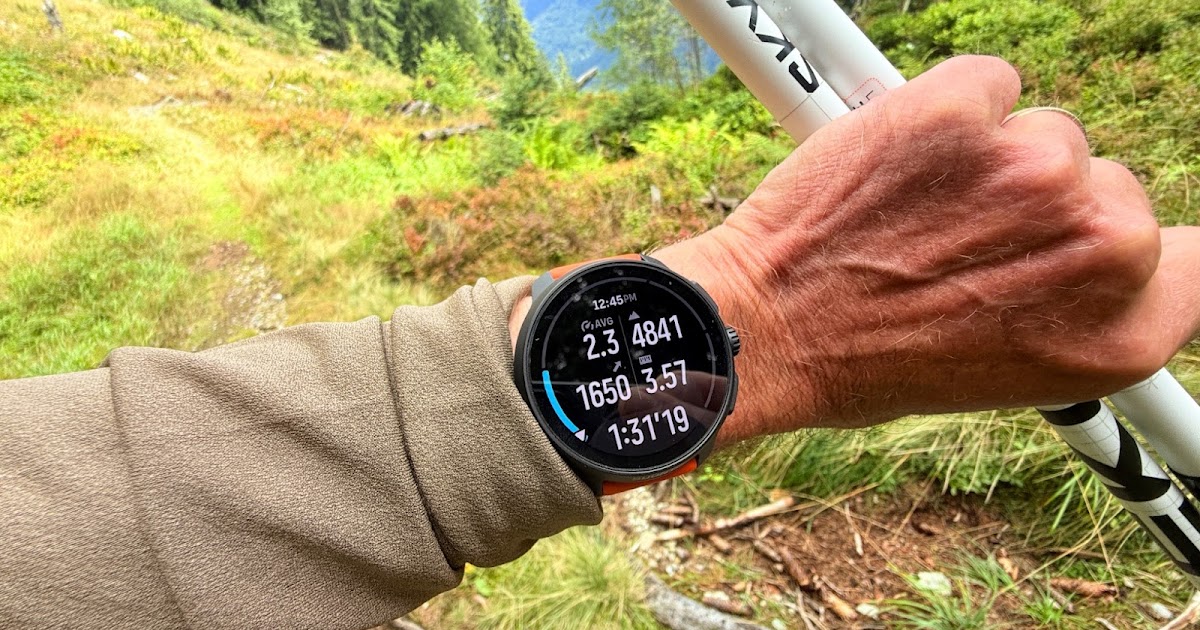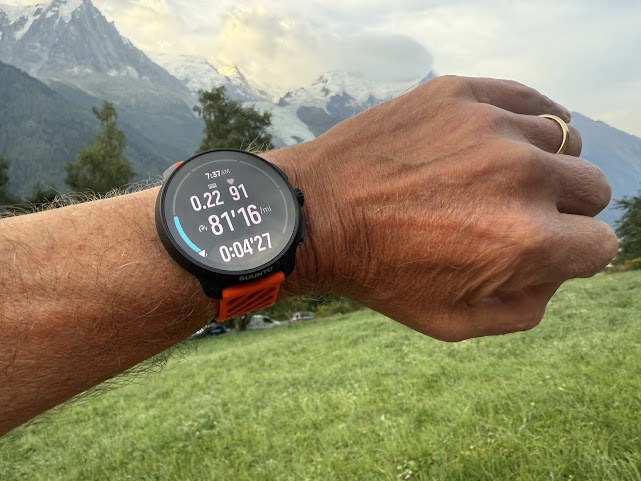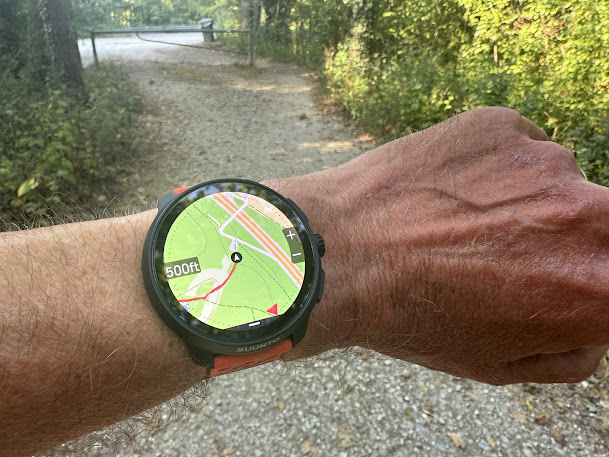The Race 2 sits in a competitive field of GPS sports and smart watches dominated by Garmin in sports and Apple in multi-function smart watches. To stand out, Suunto has staked out a focus on simplifying its interface and going all in on legibility and usability during activities and in everyday use.


Its app continues to evolve with the watch and has an elegant and “simple” yet highly comprehensive view of data.
At $499 in the stainless version and $599 for Titanium, I consider the Race 2 very competitively priced compared to Garmin and Apple sportswatches
The choice of a GPS or any watch is a highly personal one with features, fit, uses, and style all elements to consider.
Details of Features and Improvements
The Race 2 sees significant improvements over the Race 1, not changing the “basics” but clearly improving the most key elements of sensor accuracy, speed and smoothness of interactions with the interface, weight, screen size and any light condition legibility. While its price has gone up, its value has too given the improvements.
The display increases from 1.43” to 1.5” in the same 49mm case size and is clearly bigger
The AMOLED display now has LPTO technology with faster refresh rates and which, in testing, was brighter and more legible in bright sunlight than the Race 1’s or a Garmin Enduro 3.There is no longer any penalty in bright reflected sunlight vs LCD displays and it is vastly more visible in low light.
The Race 2 is now thinner at 12.5 mm (vs,13.3mm) and lighter 76g in Silicone Stainless (vs. 83g).and with the optional (s/m) fabric strap 63g. The Titanium checks in at 65g with Silicone, 51g with fabric strap
A new MCU processor is about 2x quicker leading to faster response and smoother interactions in testing. Swiping is smooth and quick and wake up from dark screen almost but not quite instantaneous
Claimed 10% improvement in battery life. In Performance Mode (notifications on) I saw about 42-44 hours of battery life with everyday battery life of about 12 days
Upgraded HR sensor and sensor location leads to definitely improved results in test with some silicone band comfort caveats and occasional (far less than Race 1) high readings in cold and/or on downhills.
GPS accuracy on par with any other recent watch.
Increased on board memory for maps, etc..but music storage on the watch is not available.
Voice guidance when paired with Suunto Wing 2 (RTR Review) standalone without a phone and via the app if the phone is with you and the app is open with notifications of changes in HR zone and mile splits (average HR, lap splits, elapsed time)
Improved charging cradle. Clearly needed and now improved but still finicky to connect if not on a hard smooth surface
Battery Life
The spec activity battery life is up to 55 hours. To achieve this one must haven always on display off, raise to wake off, and brightness low. Quite frankly, while doable, these settings especially raise to wake off are not practical for most activities.
I am seeing a very respectable 42-44 hours of battery life with Raise to Wake on, Performance mode tracking, medium brightness and notifications.The latest Apple Watch the Ultra 3 ($800) has a 14 hour activity battery life in its best performance mode as does the comparably priced and 13 g lighter with a smaller screen Garmin Forerunner 570. Win for Suunto in this category!
The “everyday” battery life spec is up to 16 days. With 24/7 HR monitoring, sleep tracking, raise to wake and notifications and with a 45 minute activity tracked per day, I am seeing about 12 days. Again very reasonable.
The charger puck is improved over the quite unreliable Race 1 which would easily disconnect.
It has proven very reliable in maintaining charging connection but only when face down on a hard surface.

On a less than hard surface it can easily disconnect. Suunto should continue to improve with if possible a stronger magnetic connection.
GPS Accuracy
GPS acquisition is consistently within less than 10 seconds. That said, if you have traveled a long distance, sync the watch to the app before your run to get up to date GPS satellite location on board.
GPS accuracy is as good as any as most GPS watches and most share the same Sony chipset with Suunto tuning for their specifications.

DCAnalyer: Blue Suunto Race 2, Purple Garmin Enduro 3
If you have a 3 or 4 years old GPS watch and suffer from inaccuracies in distance (and poor battery life) time to move on to a new watch as all watches have improved battery life.
Altimeter
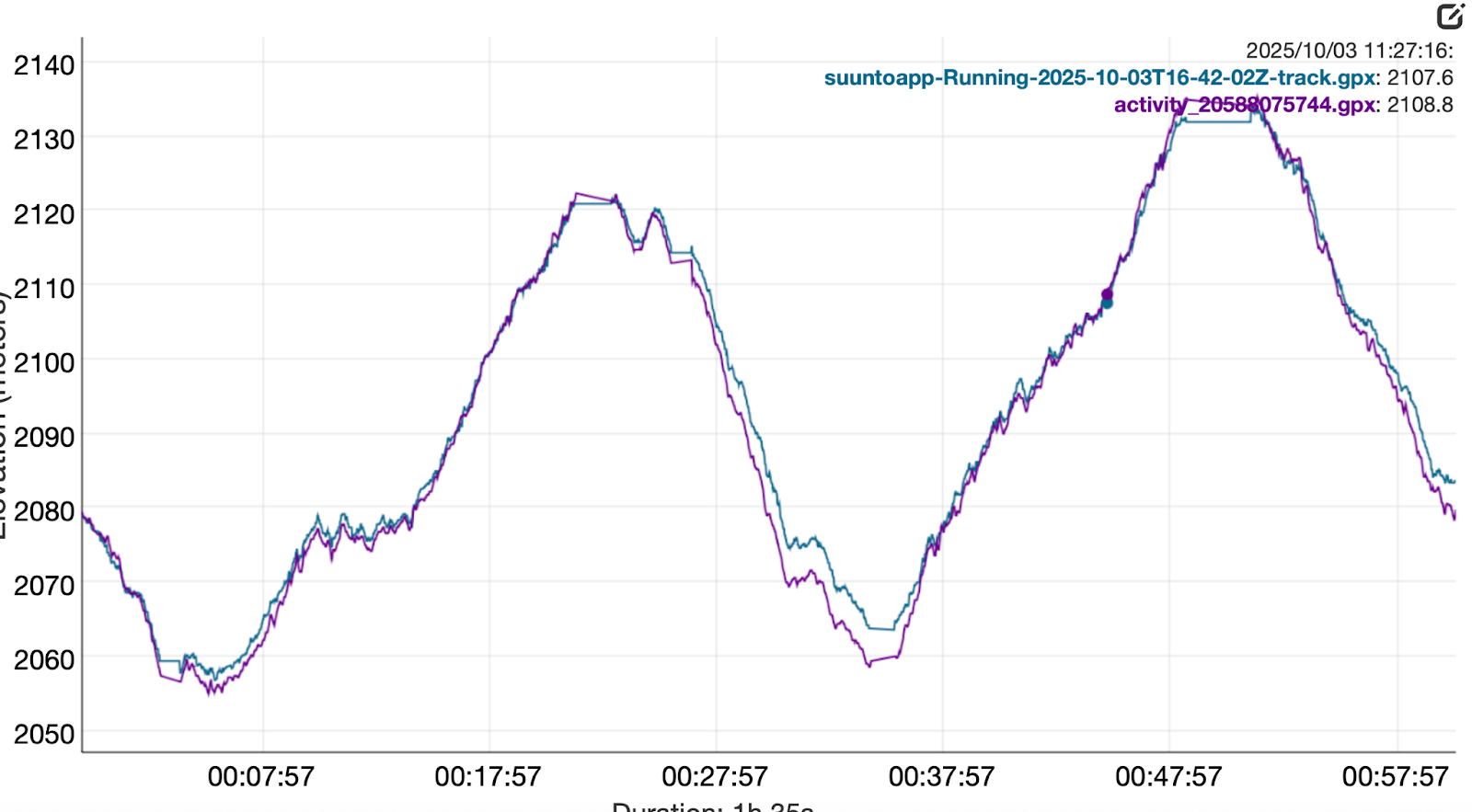
DCAnalyer: Blue Suunto Race 2, Purple Garmin Enduro 3
The altimeter tracked very closely to a Garmin Enduro 3 (about 2 x the price of the Race 2) during a trail run with biggest observed difference about 4 meters (center of image above)
During a recent half marathon the Race 2 measured the same distance as the Enduro 3, to the 100th of a mile (16 meters) with average race heart rate within one beat per minute.
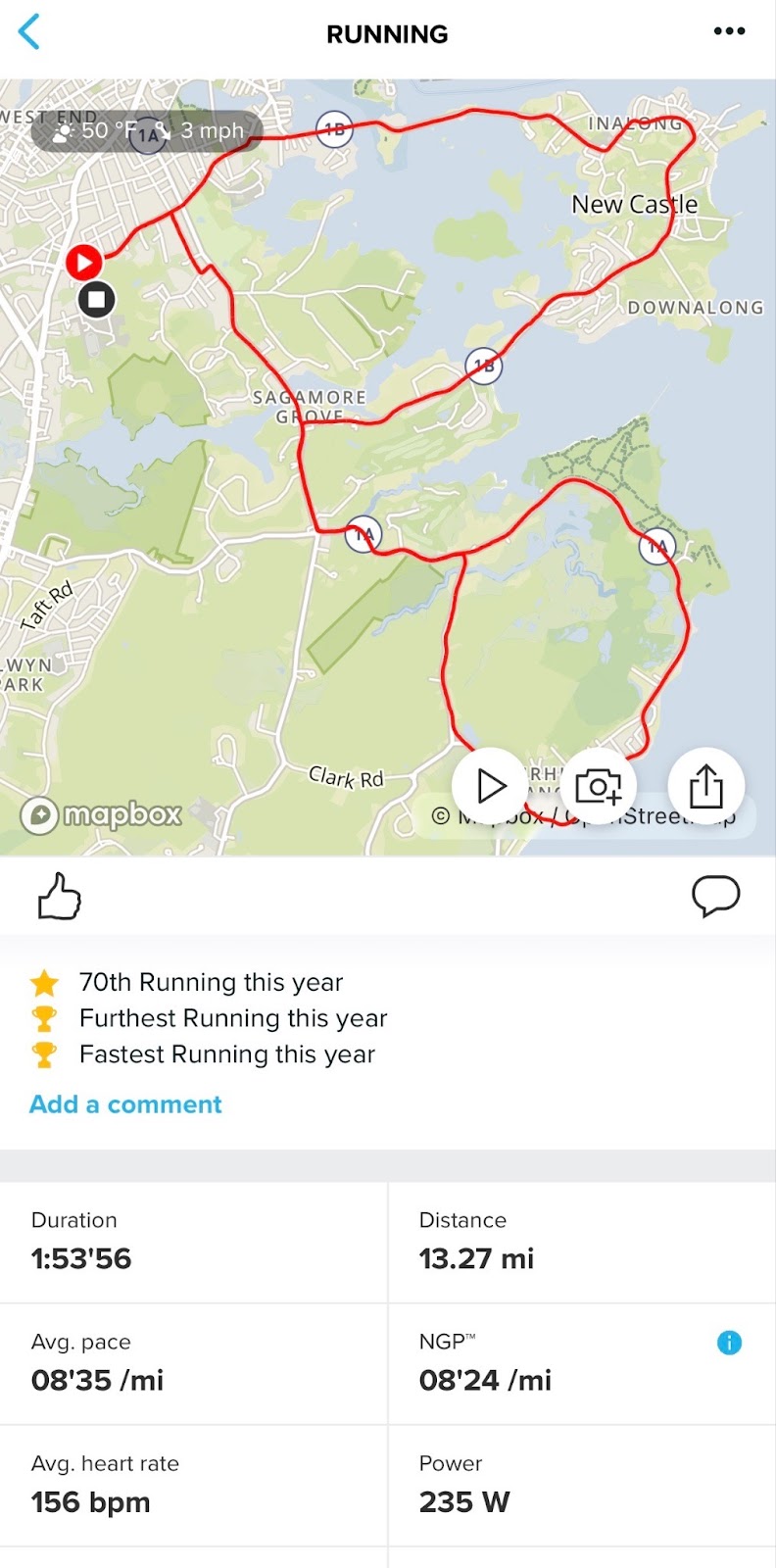
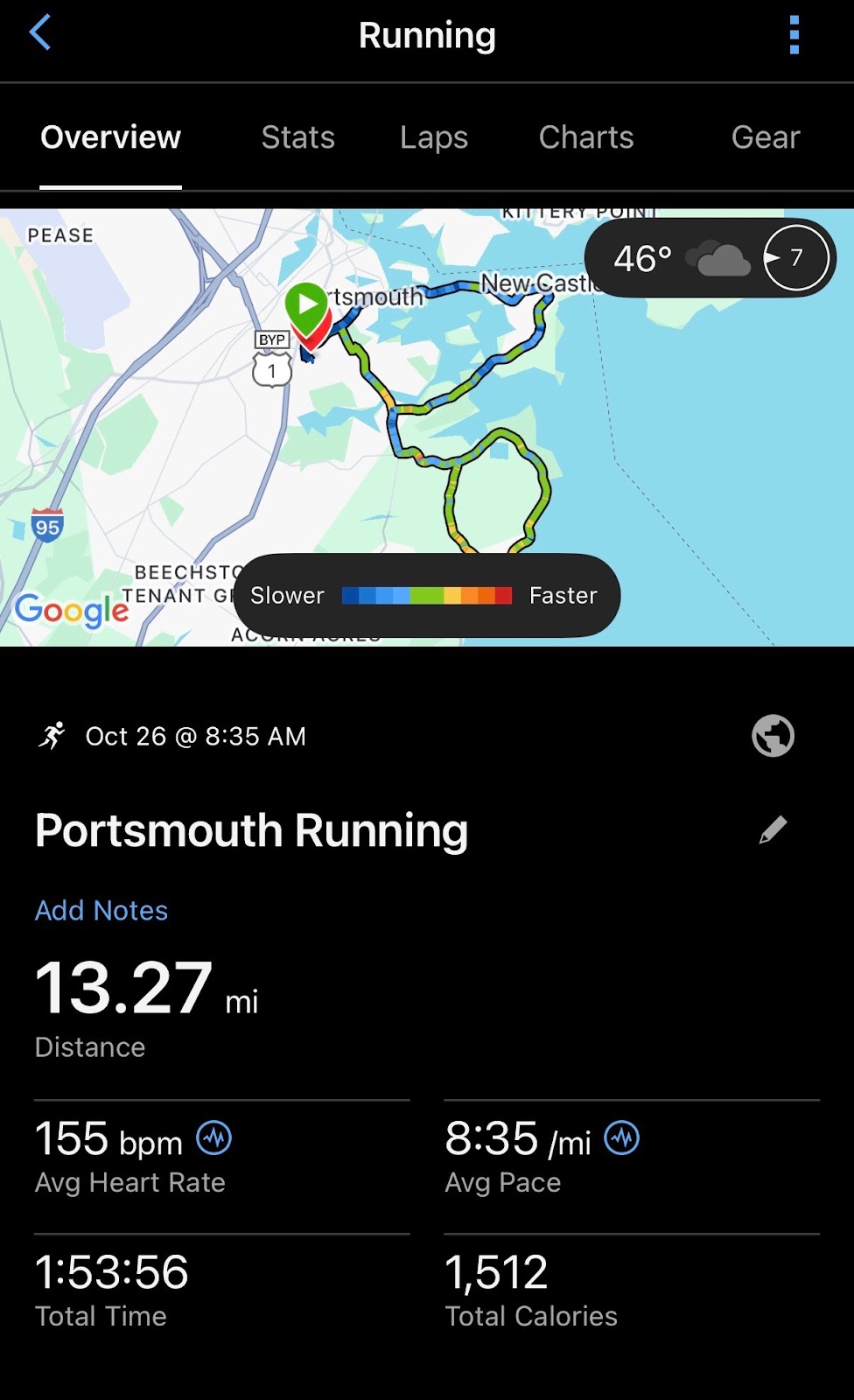
Left: Suunto (note also higher quality maps but without pace shading of the Garmin summary
HR Sensor
The Race 1 suffered from early in run overly high HR readings (cadence lock) as well as also occasionally during runs randomly. The Race 2 with its new sensor and bump out io its case is clearly improved in HR accuracy. Below HR from a trail run, I do note occasional higher spikes (but not crazy high above 170 as in Race 1) especially early in runs and as in the example below on downhills (see elevation profile above)

DCAnalyer: Blue Suunto Race 2, Purple Garmin Enduro 3
During the road half marathon on less hilly terrain the HR sensing had no spikes and was on average within one beat per minute of the Enduro 3.

There is a caveat though. With the silicone strap (not the most comfortable to begin with but snazzy) the strap has to be cinched almost uncomfortably tight to get accurate readings and especially at the start of runs.
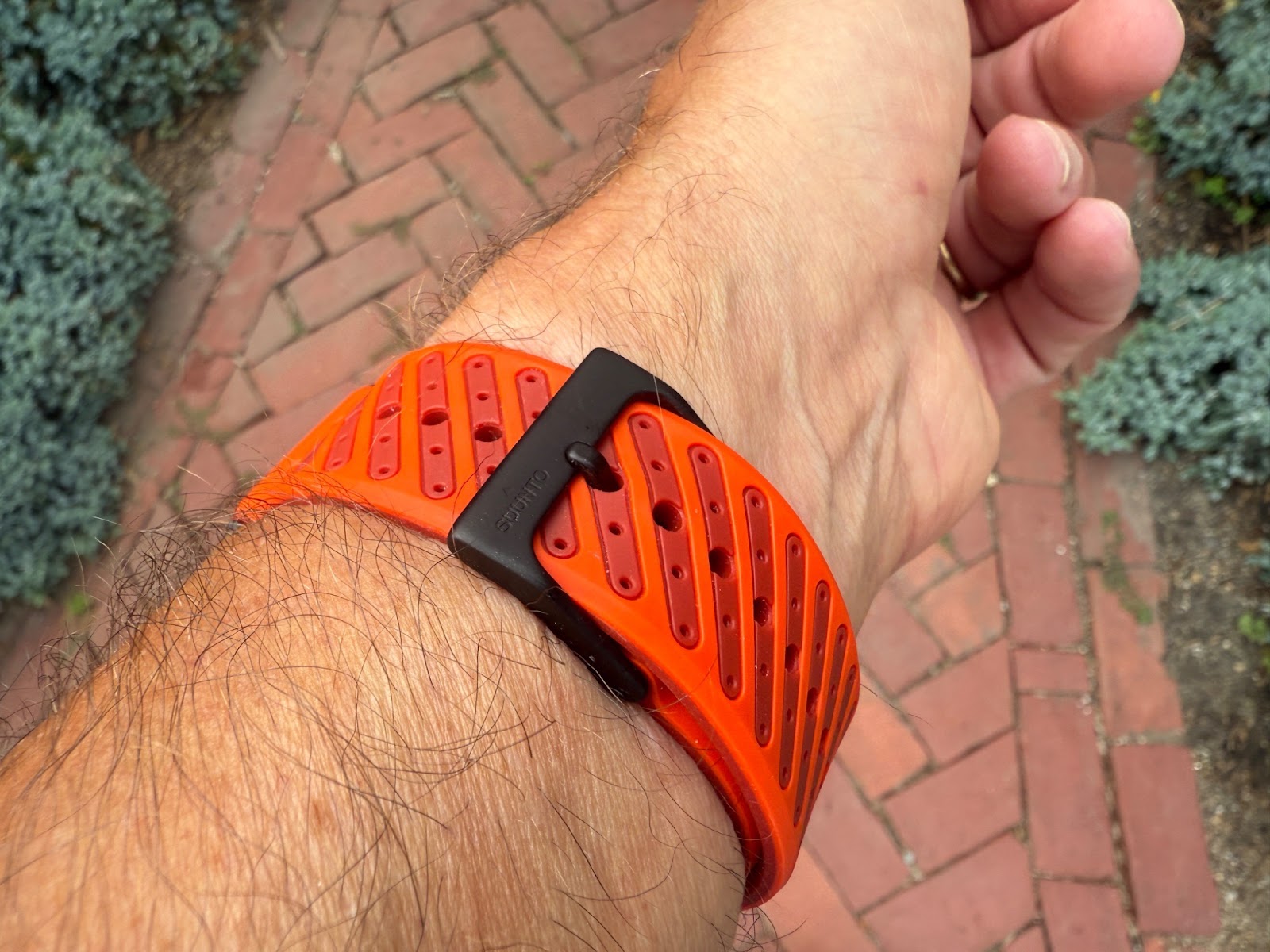
The stock strap’s comfort and speed of adjustability on the go is not helped by its traditional clasp and metal pin to secure the loose end of the strap. HR anomalies are greatly reduced as is comfort with textile straps, as I have found with most watches including the Enduro 3

The lighter optional 22mm Athletic 7 Loop Textile Strap ($29 and includes two sizes) is far more comfortable and easier to adjust, lightens the watch by 15g and produces better HR results. While the silicone strap is really cool and bright looking, I think Suunto should have by default used a fabric strap.
Auto Pause
As do most GPS watches the Race 2 supports auto pause and auto laps. While the auto laps can be adjusted for different distances the auto pause is not adjustable for pace. As such on steep hikes where paces can be very slow I found it paused when I was still moving, albeit slowly. I ended up turning it off while hiking. I would like to see auto pause pace be tunable by activity as it is with Garmin.
Voice Guidance
I do not have the Wing 2 bone conduction headphones (RTR Review) which can be paired and give voice guidance without needing to have a phone with you.
I did test voice guidance with Race 2 paired to the Suunto app on my phone by turning it on. I was notified of my heart rate and current heart rate zone when the zone changed. Useful, but on trail courses with many fairly sharp short hills such as trail running a bit overdone with overly frequent alerts as I changed HR zones. While I have not yet tested running intervals, I think it will be very useful and informative there.
I was also notified at lap (mile) splits of my lap’s pace, average heart rate and total activity time . I found the voice guidance surprisingly useful. Note that to date there is no voice guidance for turns ahead, on and off route in navigation for loaded routes you are following.
Navigation/Mapping
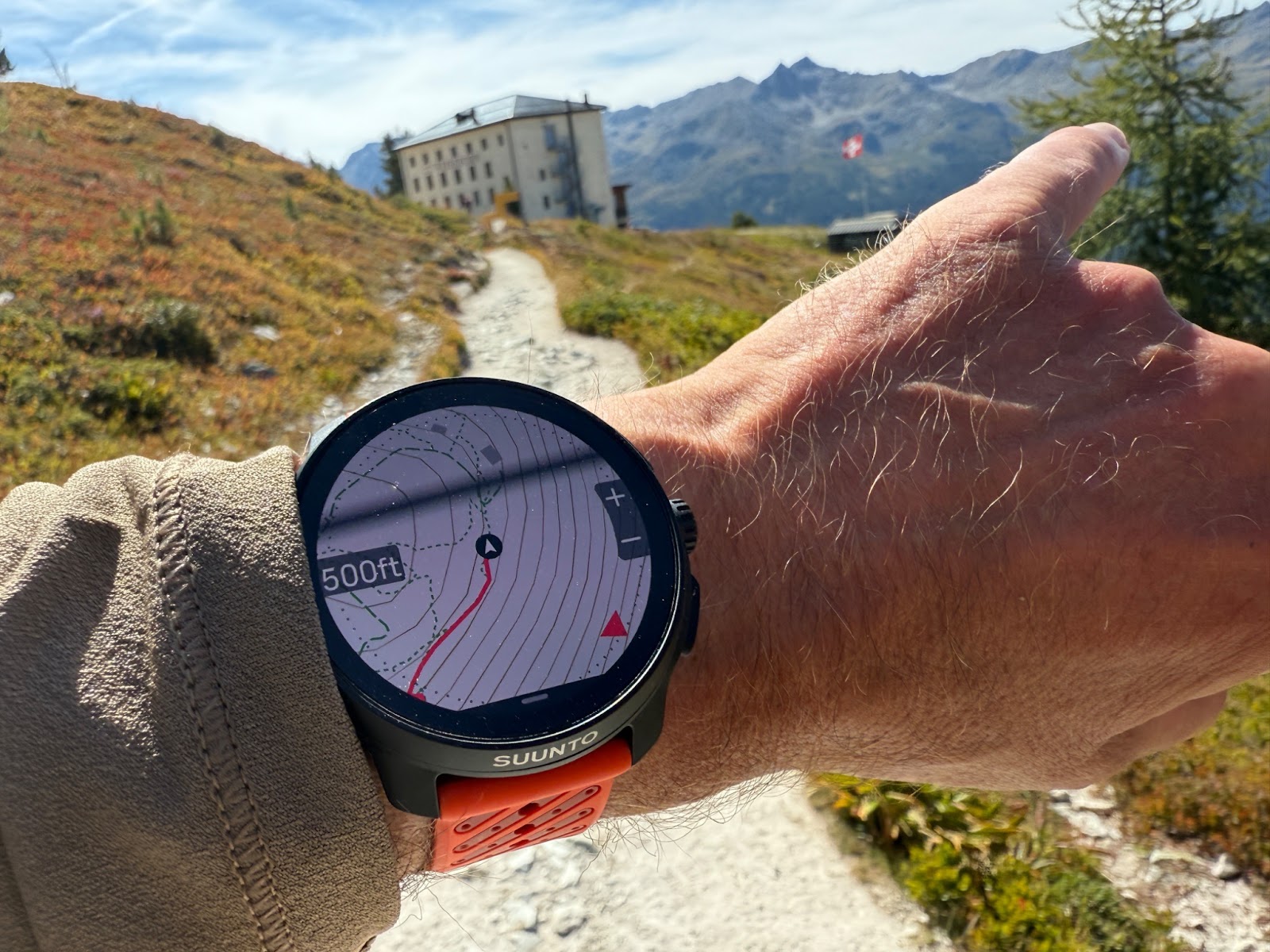
Up ahead the Hotel Weishorn on the Sierre Zinal course is clearly shown on the Race 2, above the gray line (screen artifact often captured by the camera but not otherwise seen).
The Race 2 allows you to load routes you have created in the app and follow them by default in “breadcrumb” mode or view the map without a route at any time as shown above.
Maps need to be downloaded state by state via the app and a wifi connection at the watch. The entire US map is 42Gb with the total memory on board 32Gb. Ii was able to load all of Switzerland as one download, Italy a bigger country is several.
They take time to download especially larger states so be prepared to have your watch on wifi and connected to the charger for several hours. Garmin watches with maps such as my Enduro 3 have the entire US pre loaded by default.
In my testing, I included a Garmin Enduro 3 on the other wrist with its LCD screen. What stood out was the incredible legibility of the Race 2’s maps even in very bright sun (and for sure compared to the LCD Garmin and cluttered almost crude maps) and also it has far easier to navigate map interface than the Garmin’s.

The Suunto shows buildings mostly perfectly with some exceptions with the app version showing them but the watch not (different databases).

The house and several on the other side of the street are missing from the watch map view but seen in the app view of the same (below) along with street and trail names.
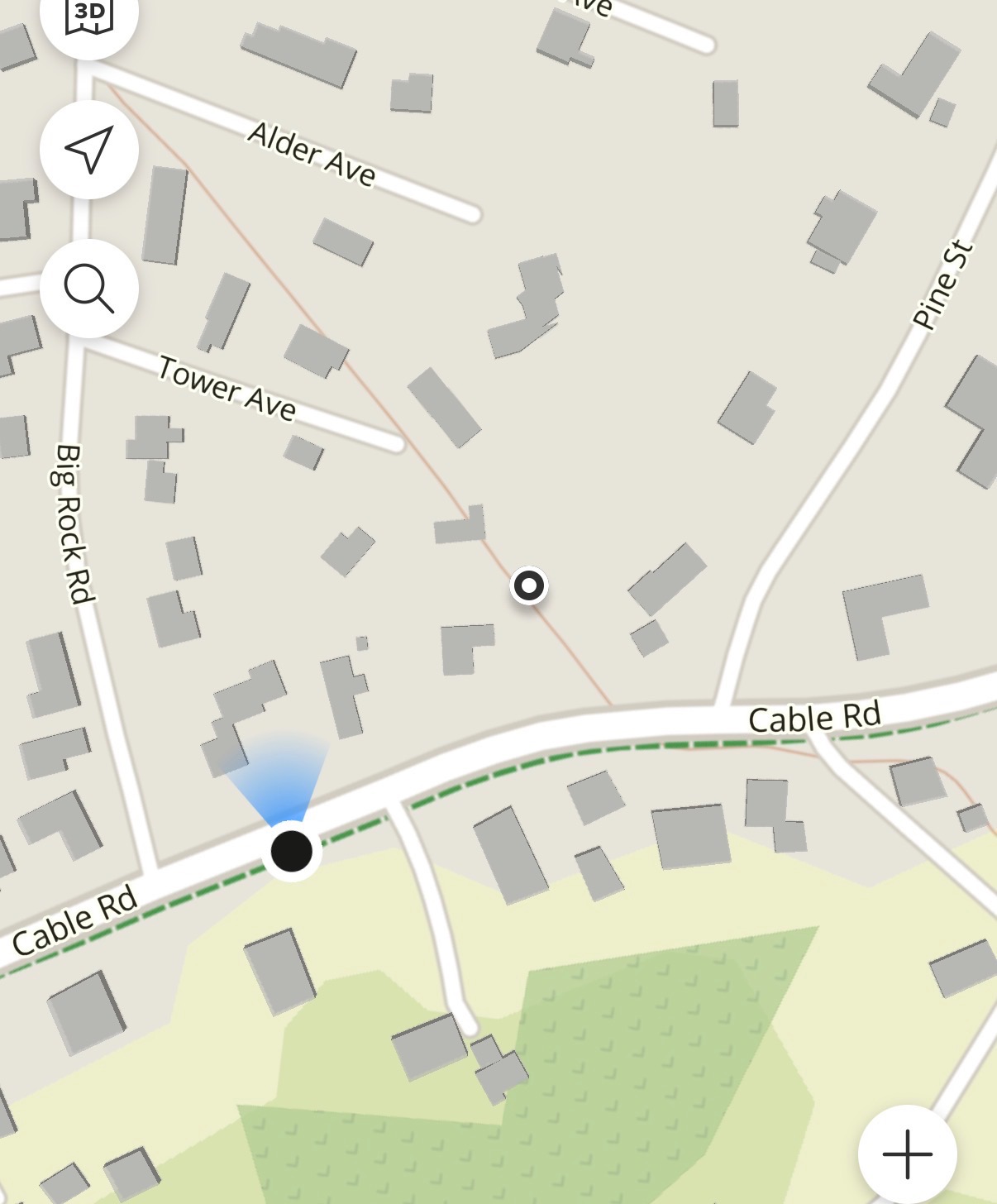
Suunto tells us different map databases are used for the watch and app views. Not a big deal although I hope in the future they can be totally synchronized as the context provided by structures is actually quite useful.
The Race 2 notifies you of upcoming turns on a loaded route. I noticed differences between road and trail notifications of turns. Interestingly, in my testing, trails turns in Park City
were far closer to accurate than roads

The Race 2 notified via vibration and on screen “off route” to its spec at 100 meters off a road route (seems at a 90 degree angle to the route) and the Garmin did the same.
I say right angle, as if you go off course at an angle it will not notify you until you are100 meters away from the correct route which can be a considerably greater distance than 100 meters.
The Race 2 notifies you of return to route when you actually resume the correct route it consistently says you are 40-60 feet away from being back on route when you are right at the turn. Some fine tuning is needed for road turn by turn navigation.
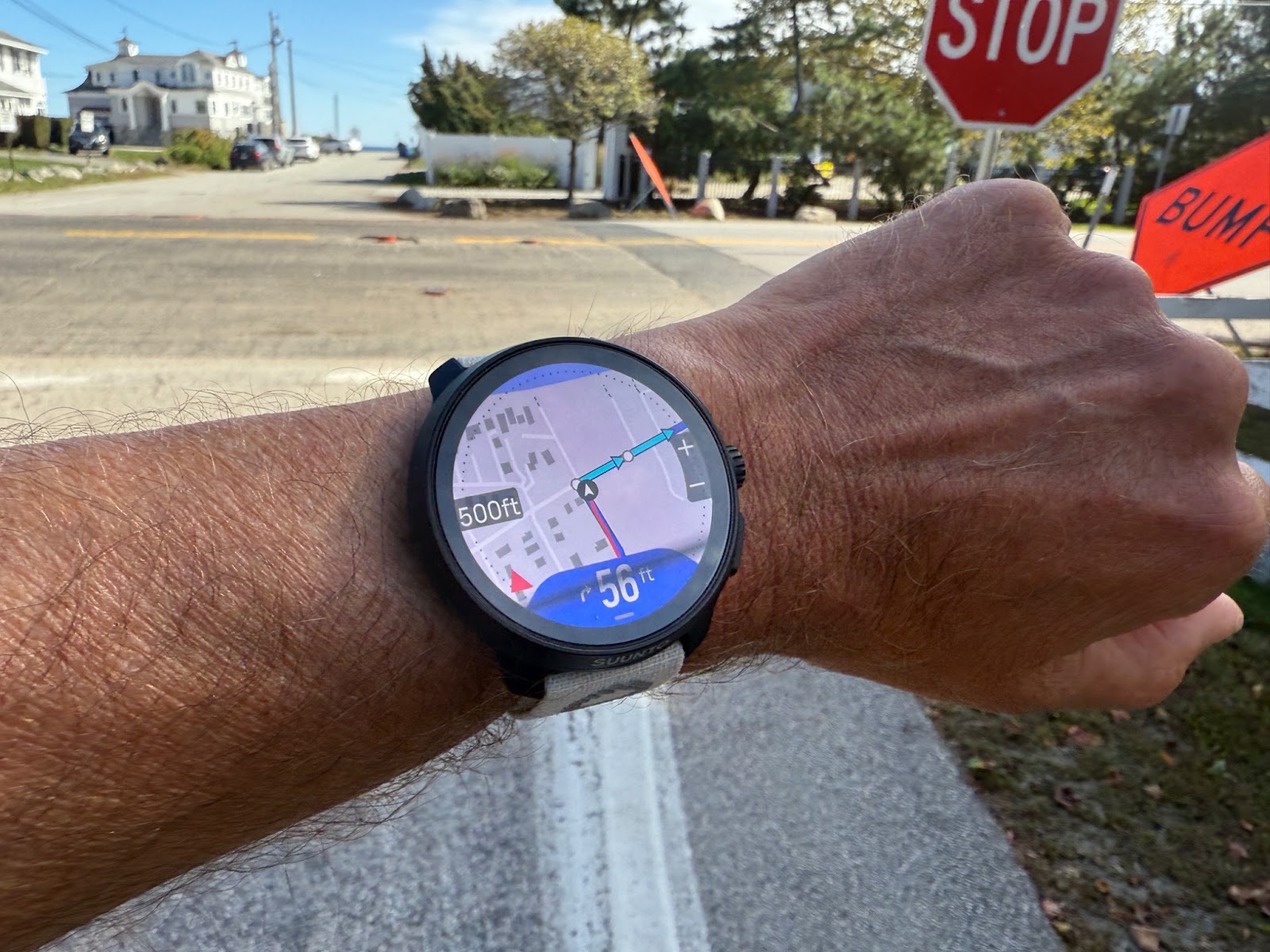
On trails in Park City turn indications are closer to being accurate.
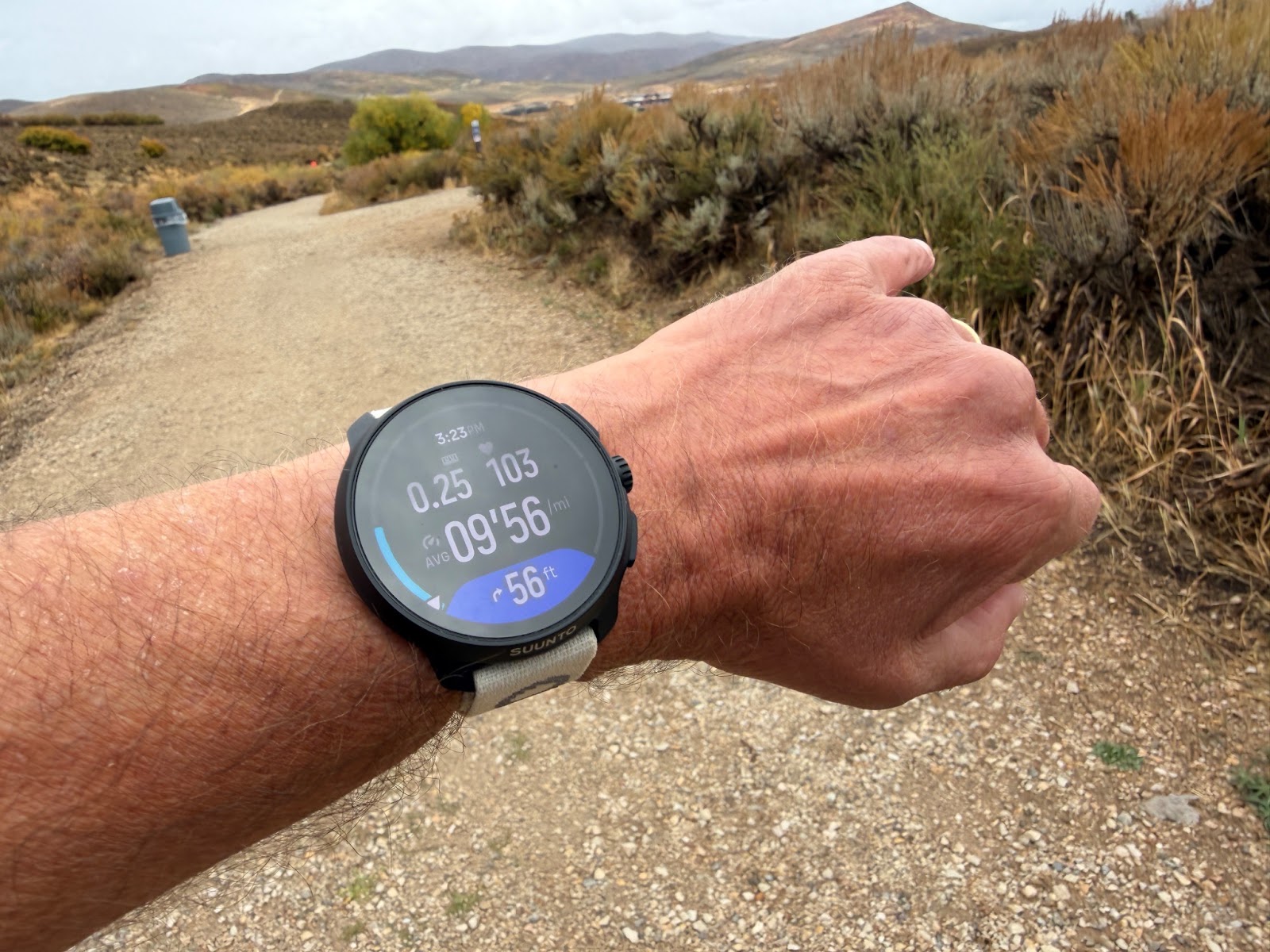
Associated with navigation by routes, are screens for climbs ahead and done on the route.
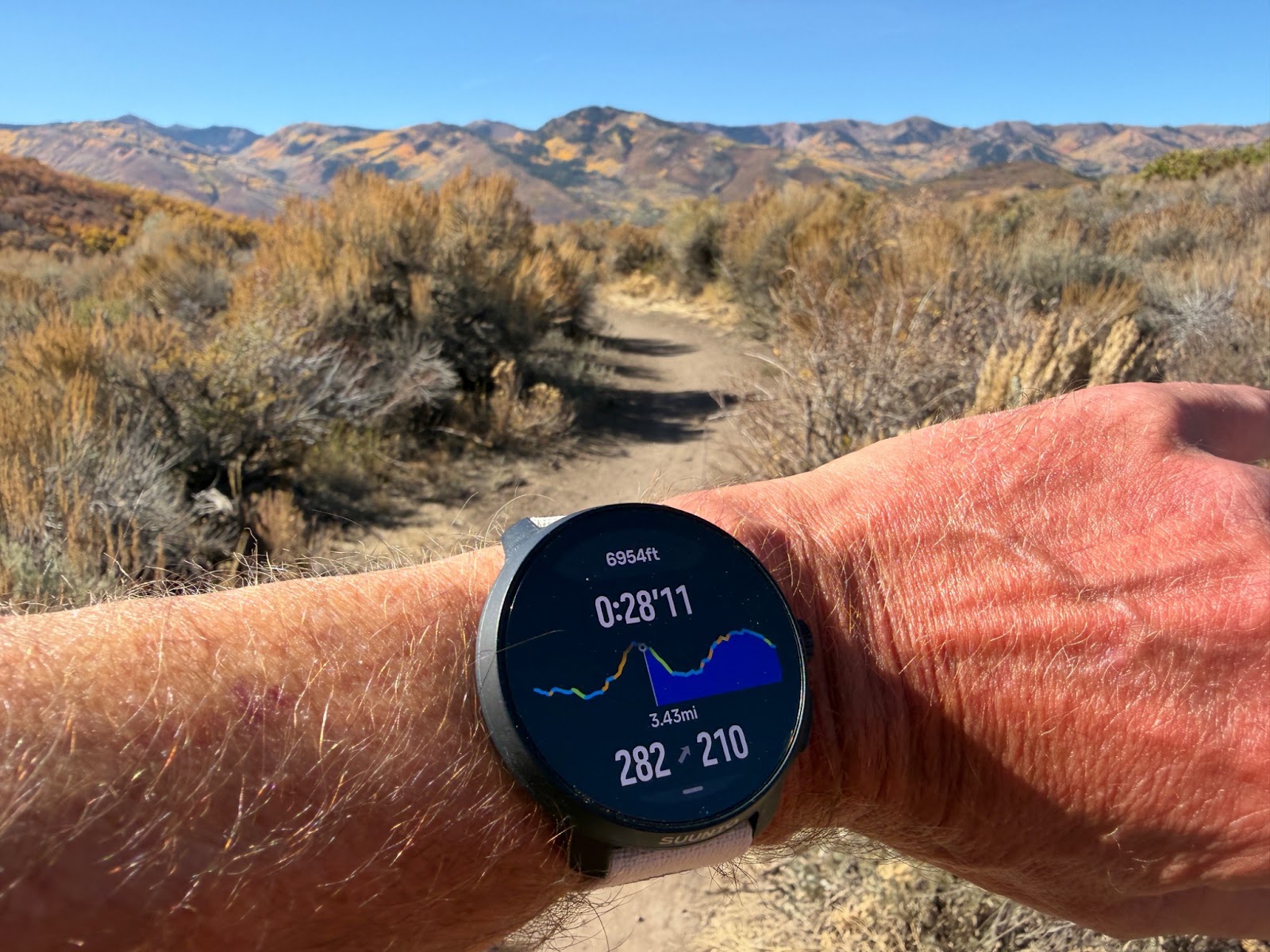
As with the maps themselves, they are crystal clear, simple and easy to understand.

Not perfect, yet but very easy to use from route creation to on the go interactions and of course with superb legibility.
To create a Route you find the general area and decide if you want to follow known roads and trails (or not) and easily click in segments noting that it may try to route you differently than intended if you aren’t zoomed in tight enough to click as you wish. As shown below, your created new route will include not only an elevation profile and details but also turns (blue arrows) the watch will alert you to. Then decide if you want to load to the watch. The synch is quick and reliable.

Super easy and elegant compared to apps such as Komoot and similar to Garmin.
Flashlight
The Race 2 has a flashlight which can be activated by assigning it to one of the buttons. A long press in my case at the top button turns it on. A click on the center crown dial turns it off. It is adequate for quick trips to the bathroom at night and walking but is not a substitute for a headlamp.
Music/Podcasts
You can control music or podcasts from the watch to your phone but you can’t currently store and play music directly from the Race 2.
Sleep and Recovery. Training and Progress Status
The sleep monitoring is very accurate in terms of recording total actual sleep and taking into account any wake ups during the night, even if somewhat prolonged. I have never had it stop recording as my Garmin Enduro sometimes does if I wake up for more than a few minutes and move around at night..


